Updated in January 2025!
Are you thinking about moving to Thailand with your kids? Do you have doubts and don’t know what to expect? You’re not alone.
Many families are looking to escape Western countries and create a better, more enjoyable life for their children. I’ve got you covered! We moved to Thailand in 2019 with our two-year-old daughter, and two years later, our second daughter was born there.
In this article, I’ll share our experiences of living in Thailand with kids. I’ll help ease your fears and cover topics like transport, housing, safety, food, childcare, and education.
Honestly, moving to Thailand with my family was one of the best decisions I’ve ever made!
Our Journey to Thailand
We were unhappy with our life in Germany. Stuck in the 9-5 grind, we barely saw our daughter and had little time together as a family. The worst part was feeling trapped. To afford our trendy downtown apartment in Hamburg, we had to go to jobs we didn’t really like every day.
We had too little time and flexibility to take the trips we wanted. Like many people, this lifestyle just made us unhappy. We wanted more from life—more control and more freedom. So, we decided to become digital nomads.
In October 2019, after about a year of preparation, we finally boarded a plane to Bangkok—a one-way ticket, of course. We were so scared, but at the same time, we knew, living in Thailand with kids was the right decision.
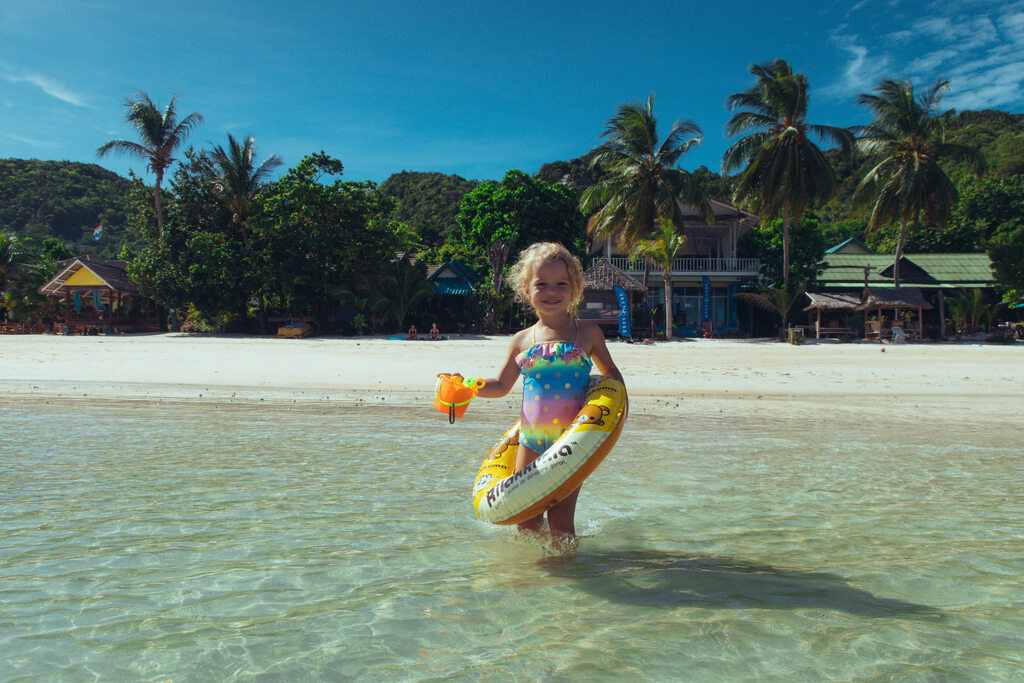
Why We Chose Thailand – Initial Expectations and Fears
We were already familiar with Thailand from several vacations before (without children) and loved it. We knew that to start this new lifestyle, we needed a place we knew, that was easy to travel, safe, and affordable.
For example, we knew that in Chiang Mai, in the north, we could acclimate to the weather before moving to the tropical south later. We also knew that childcare was affordable and of good quality, so we could get back to work right away.
However, we were aware that Thailand didn’t quite match our German standards for safety, particularly in terms of traffic. As vegetarians, we were also a bit worried about the limited food variety.
And we had no idea how our daughter Lila would communicate. At least we had English; for her, there was no way to communicate.
Arrival in Thailand – The First Day in Thailand as a Family
The plan: After a 20-hour trip, we planned to spend a few days in Bangkok before moving on to Chiang Mai. But when we arrived in Bangkok, we got a shock: Lila immediately had stomach problems and vomited. The hotel was a total disaster, with loud music all night, and the heat was tough on all of us. Argh.
I’ll never forget walking through Khao San Road with two-year-old Lila in our arms for the first time. Overwhelmed by the noise and sights, she immediately fell asleep.
Despite the exhausting start, those first days were also full of wonderful surprises. The Thais welcomed Lila so warmly (unlike in Germany, where children are often seen as a nuisance in public). Dizzy and I found the coolest co-working spaces with stunning views of Bangkok.
After a few days in Bangkok, we flew to Chiang Mai. We planned to stay there for three months, aiming to establish a proper daily routine with a new school for Lila and a real “office” for the first time in Thailand.
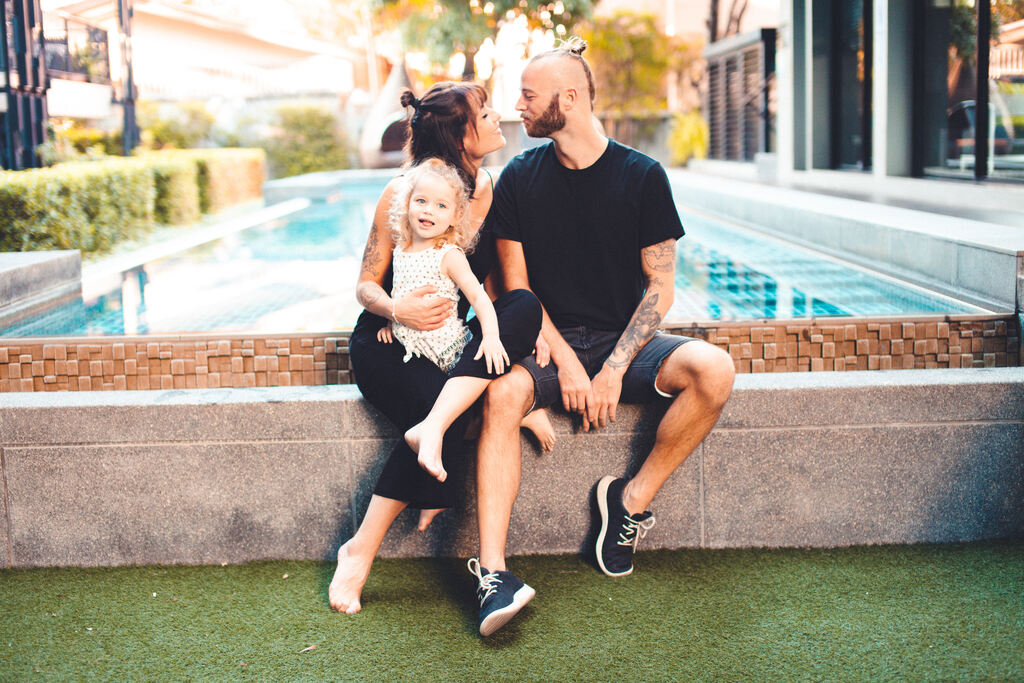
Settling in Chiang Mai and Koh Phangan
In Chiang Mai, we treated ourselves to a nice hotel in Nimman (we learned from our mistakes: after a long flight, don’t skimp on the hotel because good sleep is crucial!). From there, we explored the neighborhood by bike and decided on a corner of the district we liked.
We walked into condos and asked about available apartments. Quickly, we found an affordable condo with a pool on a quiet street (LIV@Nimman, highly recommended!). Next, we asked the international kindergarten around the corner if they would take Lila for three months. They had a spot available!
Looking back on this time, I realize how naive we were. It’s great that everything worked out so well, but it could have easily gone wrong. My planning was truly poor at that time.
In January, we moved to Koh Phangan. Yes, in January, the peak of the high season. Finding an affordable place to stay was much harder. At that time, in early 2020, there were also very few kindergartens. Still, we immediately found a spot for Lila.
So that’s our arrival story in Thailand. Now, I want to share the most helpful advice for living in Thailand.
Finding Accommodation in Thailand
How do you find suitable accommodation as a family living in Thailand with kids? It depends entirely on the location and season. Here’s the approach I recommend:
Book an initial accommodation: Start by booking a reliable place to stay through Booking.com or Airbnb. Make sure it’s somewhere you’ll feel comfortable for the first few days. This gives you a convenient base to explore from.
Orient yourself: Begin exploring the neighborhood. Use Google Maps as a guide, see what you like, and which areas might be suitable for your new home. Find out where the best schools, kindergartens, co-working spaces, and leisure activities are. Where is the action? Where can you quickly find a community?
Find accommodation:
- In Thailand, look out for signs posted on the roadside advertising houses for rent. Call the numbers listed, as landlords usually live nearby and can show you the property right away. In bigger cities, ask directly at the doorman’s office. They often have keys to vacant apartments and can show them to interested parties.
- For long-term rentals, I’ve had the most success on Facebook Marketplace. There, I’ve found the cheapest and best long term offers from local landlords.
- In cities like Chiang Mai and Bangkok, it was a good choice for us to work with real estate agencies. It’s simple: you email them your requirements, and they send back a list of offers. If you choose one, the landlord usually pays the agency fee.
- Airbnb and Booking.com can also be good sources. However, since Airbnb has high fees, I recommend finding the landlord outside of Airbnb (often, the house name or the landlord’s full name is given). This way, you save fees and build a direct relationship with the landlord.
- Sign a lease: In Thailand, it’s common to agree on a deposit, usually a maximum of one month’s rent, which can be paid in cash or by transfer.
Check out these amazing hotels in Bangkok, or use the map below. 👇
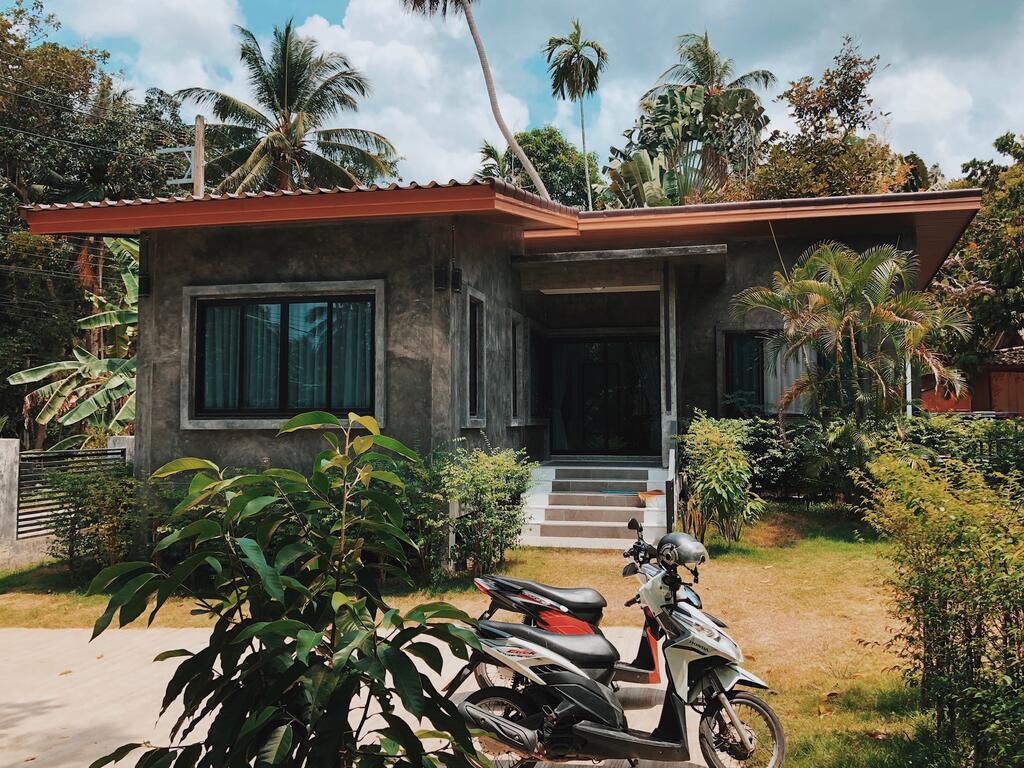
Special Tips for Renting Accommodation in Thailand
- If you notice anything broken in the house, take a photo immediately and send it to the landlord or house manager. This increases the chances that the item will be replaced or that you won’t be held responsible for it. Unfortunately, we’ve experienced situations where we pointed out broken items only at the end of the rental period and ended up having to pay for them, even though we didn’t cause the damage.
- Also, don’t be surprised if the landlord takes a photo of you with the money in hand. In some circles, this is considered proof that the first rent or deposit has been paid.
Schools and Education
The school system in Thailand consists of several levels and follows a structure that is similar to many Western education systems. Here’s how it looks:
Structure of the Thai Education System
Pre-Primary Education
- Age Group: 3-6 years
- Levels: Kindergarten (K1 to K3)
- Pre-primary education is not compulsory but widely available.
Primary Education
- Age Group: 6-12 years
- Levels: Grades 1-6
- Primary education is compulsory for all children.
- Subjects include Thai language, mathematics, science, social studies, health, and physical education, arts and crafts, and basic technology.
Secondary Education
- Age Group: 12-18 years
- Levels: Divided into lower secondary (Grades 7-9) and upper secondary (Grades 10-12)
- Lower secondary education is also compulsory.
- Upper secondary education is split into academic tracks (focused on sciences, arts, and languages) and vocational tracks (focused on technical and vocational training).
Higher Education
- Institutions: Universities, colleges, and technical institutes
- Offers undergraduate, graduate, and postgraduate programs. There are both public and private higher education institutions in Thailand.

Education for Foreigners in Thailand
Whether your child can attend a Thai government school or kindergarten depends on several factors, with a bit of good luck playing a significant role. In some regions, it’s common for foreigners to attend Thai schools; in others, it’s not allowed.
For example, in 2019 on Koh Phangan, we tried to enroll Lila in a Thai kindergarten, but they just shook their heads and turned us away. This particular institution only accepted Thai students.
However, on the neighboring island of Koh Tao, we have friends whose children attend the local Thai school, possibly because there are no other alternatives there.
When considering whether to send your child to a local school, keep in mind that they probably don’t speak Thai yet. Personally, I don’t think this is a problem, especially in kindergarten, as young children learn quickly.
However, by primary school, it’s essential to provide private Thai lessons alongside regular schooling to help your child keep up with the curriculum.
International Schools and Kindergartens in Thailand
According to the International School Database, there are about 140 international schools in Thailand. These teach a variety of curricula such as the International Baccalaureate (IB), British, American, and other national curricula. Unfortunately, there is no exact number of international kindergartens.
But especially in places with many expats, international families, and tourists, there is a wide selection of international kindergartens.
Many wealthier Thai families also value their children learning English and often choose an international kindergarten or school. Check out my articles on international schools and international kindergartens in Koh Phangan.
How to Apply for an International School or Kindergarten
Honestly, I’ve found the process quite straightforward in Thailand. Once we knew our next destination, I searched for private schools and kindergartens, read reviews, and asked in Facebook forums where other expat parents send their kids.
Then I contacted the schools and reserved a spot, usually paying a deposit as well. I know this requires a lot of trust in something you haven’t seen in person, but sometimes you have no other choice.
As a digital nomad, I’ve learned that you can’t control and plan everything down to the last detail, especially when different cultures and language barriers come into play. However, we’ve generally been more pleasantly surprised than disappointed.
I will never forget how Lila came back from her first day at a Thai kindergarten and showed us how they meditate in the morning—with a wai and in the Buddha seat. We were so delighted!
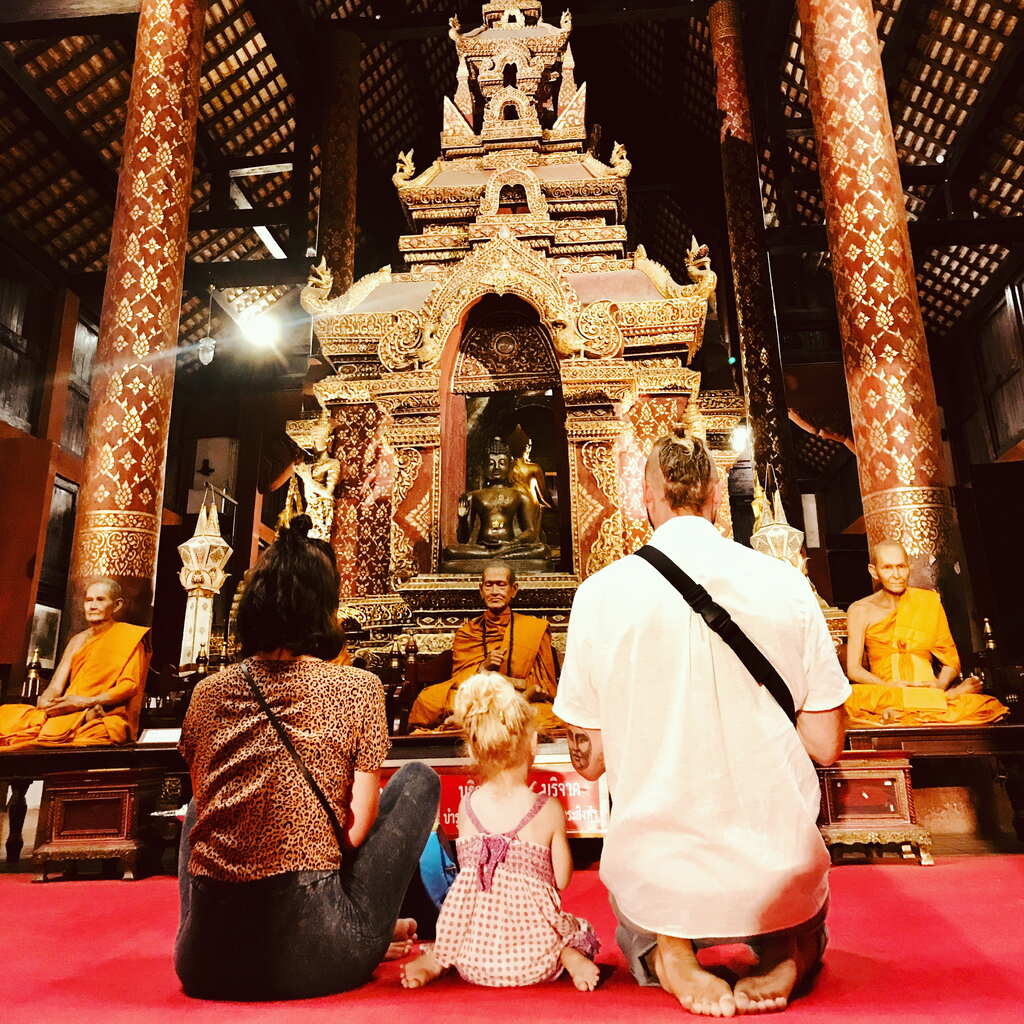
Best Visa Options in Thailand for Families
In 2019, we entered Thailand with a Visa on Arrival. After that, my husband enrolled as a student at a Muay Thai boxing school in Chiang Mai. After six weeks, we flew to Ho Chi Minh City in Vietnam and applied for an ED visa (student visa) for my husband and a dependent visa for our daughter and me at the Thai embassy.
A day later, we picked up our visas and re-entered Thailand. This visa allowed us to stay in the country for a whole year. We could have extended the ED visa twice more but opted for the Elite Visa (Thailand Privilege) instead.
The Elite Visa, depending on the package you choose, allows you to stay in Thailand for 5, 10, or 20 years. It’s very expensive, but for us, it was worth it to avoid the constant visa runs with a toddler and visits to the immigration office.
Meanwhile, Thailand has introduced a Digital Nomad Visa, officially known as the Long-Term Resident (LTR) visa. This visa allows you to stay in the country for up to 10 years at a very low cost and allows you to apply for a work permit. You can find more information about the visa on the official website.
Another affordable option for moving to Thailand is to apply for the ED visa (Non-Immigrant ED Visa) for your children. This is possible at international schools that are licensed for this. It also provides options for parents to obtain a visa to stay with their children who are studying in Thailand (one parent can get a guardian visa per child). Here’s the official info on the ED Visa.
Key Features of the ED Visa for Kids and Accompanying Parent
ED Visa for Children
- Eligibility: Children enrolled in an accredited educational institution in Thailand, such as an international school or language school.
- Duration: Typically granted for one year and can be renewed annually as long as the student remains enrolled.
- Documentation Required:
- Enrollment letter from the school
- Copy of the child’s passport
- Proof of tuition fee payment
- Completed visa application form
- Photos, as per Thai immigration requirements
Guardian Visa for Parents
- Eligibility: One parent or legal guardian of a student holding an ED visa.
- Visa Type: Non-Immigrant O Visa (Guardian Visa)
- Duration: Generally matches the duration of the child’s ED visa, renewable annually.
- Documentation Required:
- Proof of relationship (birth certificate of the child)
- Copy of the child’s ED visa and passport
- Guardian’s passport
- Proof of financial means (often required to show a bank balance of a bank account in Thailand)
- Health insurance might be required for the parent
Application Process
- Step 1: Apply for the ED visa for the child at a Thai consulate or embassy outside Thailand. This involves submitting all necessary documents and proof of enrollment.
- Step 2: Once the child’s ED visa is granted, the parent can apply for the Non-Immigrant O visa. This can sometimes be done concurrently, depending on the consulate’s policies.
- Step 3: Both the child’s ED visa and the parent’s guardian visa can be extended annually within Thailand at the local immigration office, given that all requirements continue to be met.
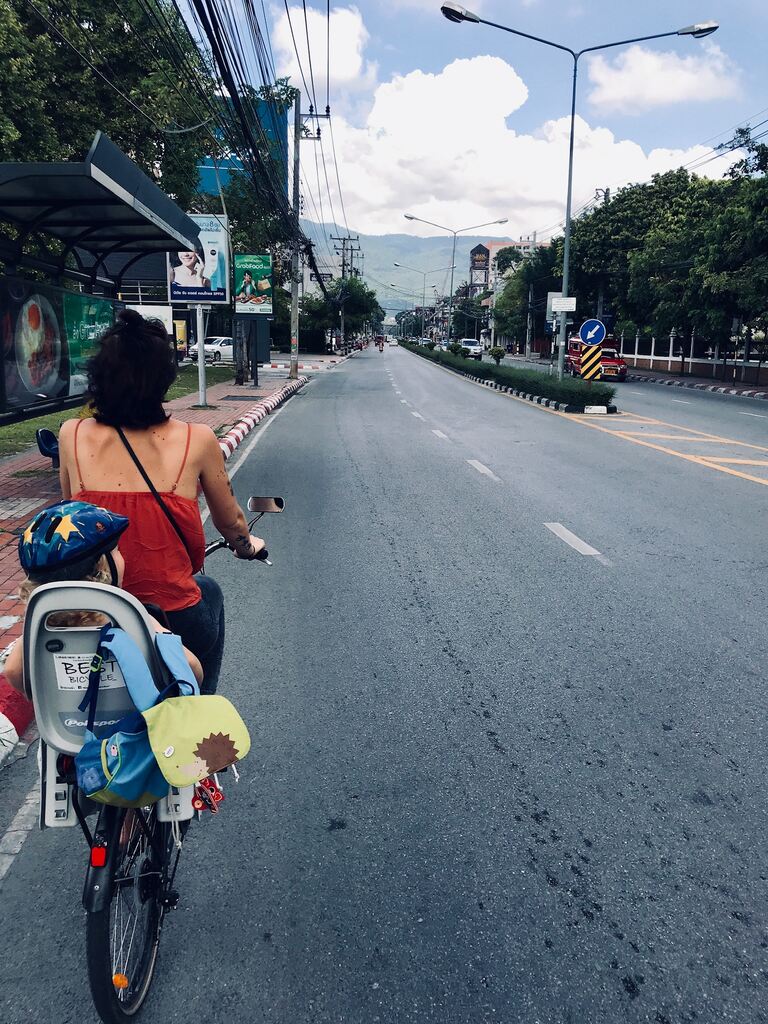
Healthcare Standards in Thailand
Quality healthcare is a major concern for many families, and rightly so. No one wants to be in a situation where a family member can’t get the help they need due to poor healthcare—a terrible thought!
Let me assure you: Thailand has some of the best hospitals in the world, with state-of-the-art medical facilities and excellent medical care! Of course, this isn’t the case on the smallest, least developed islands, but on larger islands and especially in big cities, the quality is top-notch.
I gave birth to our second daughter, Ruby, in 2021 at Bangkok Hospital Samui. This experience was far better than my experience in Germany. Here, I described my whole journey of giving birth in Thailand as a foreigner in detail.
My husband and I also had major surgery at Bumrungrad Hospital in Bangkok, and Lila was hospitalized for a week with pneumonia at First Western Hospital in Koh Phangan. All of these were top-notch experiences that couldn’t have been more professional or better in Germany.
So, don’t worry about whether healthcare in Thailand is good enough. As long as you’re not planning a heart transplant in Koh Tao, you’ll be satisfied.
Just always make sure you are well insured. Here I listed the best digital nomad health insurance providers.
Our experience in Thailand has also shown that if hospitals hear you have Western insurance, prices can double or triple. So, having insurance that covers many cases and handles contact with the hospital smoothly is worth its weight in gold!

Daily Life in Thailand
Lifestyle and Local Customs
You quickly get used to the lifestyle here in Thailand. Sabai sabai – everything is a bit slower, but it will be fine.
It took me a few months to shed my German efficiency and self-inflicted (often unnecessary) stress. When moving to Thailand, you learn to trust the Thai people. When they say the long-tail boat is coming soon, it’s coming soon. That could mean anything from 5 minutes to an hour. But it’s not worth stressing or getting upset over.
For these situations, I always carry water, AirPods, and something to read. I recommend this to anyone planning to stay longer in Thailand.
Communication
When living in Thailand with kids, you’ll eventually need a Thai number, which means getting a SIM card. My tip: Don’t buy a SIM card directly at the airport. Instead, go to an AIS store and get your SIM there. You can also convert it to an e-SIM if needed. This is the most cost-effective option and ensures you have access to AIS’s excellent service.
While there are other good providers, our best experiences have been with AIS. We heard from other expat families that they also like TRUE.
Climate
Anyone who visits us from Europe always groans, “How do you stand this heat?!” The answer is simple: the body gets used to everything! The sweating, at least for me, hasn’t lessened even 5 years after moving to Thailand. But I don’t find the usual 30 degrees Celsius (86 degrees Fahrenheit) hot anymore. In fact, when it’s only 27 degrees Celsius (80.6 degrees Fahrenheit), I wear a sweater.
Before moving to Thailand, you should familiarize yourself with the different seasons in Thailand, as they vary slightly from region to region. But generally, you can assume the following:
Hot Season (March to May)
- Temperature: High temperatures ranging from 30°C to 40°C (86°F to 104°F).
- Climate: Generally dry with occasional thunderstorms. The heat can be intense, particularly in April, which is typically the hottest month.
Rainy Season (June to October) in the north, October – December in the southeast
- Temperature: Slightly cooler than the hot season, with temperatures ranging from 25°C to 35°C (77°F to 95°F).
- Climate: Characterized by heavy rainfall and high humidity. Rain is usually in the form of short, intense downpours, often in the late afternoon or evening.
Cool Season (November to February)
- Temperature: Most comfortable temperatures ranging from 20°C to 30°C (68°F to 86°F).
- Climate: Dry and cool, especially in the northern regions. This is the most pleasant time of year to visit, with mild temperatures and low humidity.
Regional Variations
- Northern Thailand: Experiences cooler temperatures during the cool season, especially in mountainous areas like Chiang Mai and Chiang Rai.
- Southern Thailand: More consistent temperatures year-round, with the west coast (Phuket, Krabi) experiencing the rainy season slightly earlier than the east coast (Koh Samui, Koh Phangan).
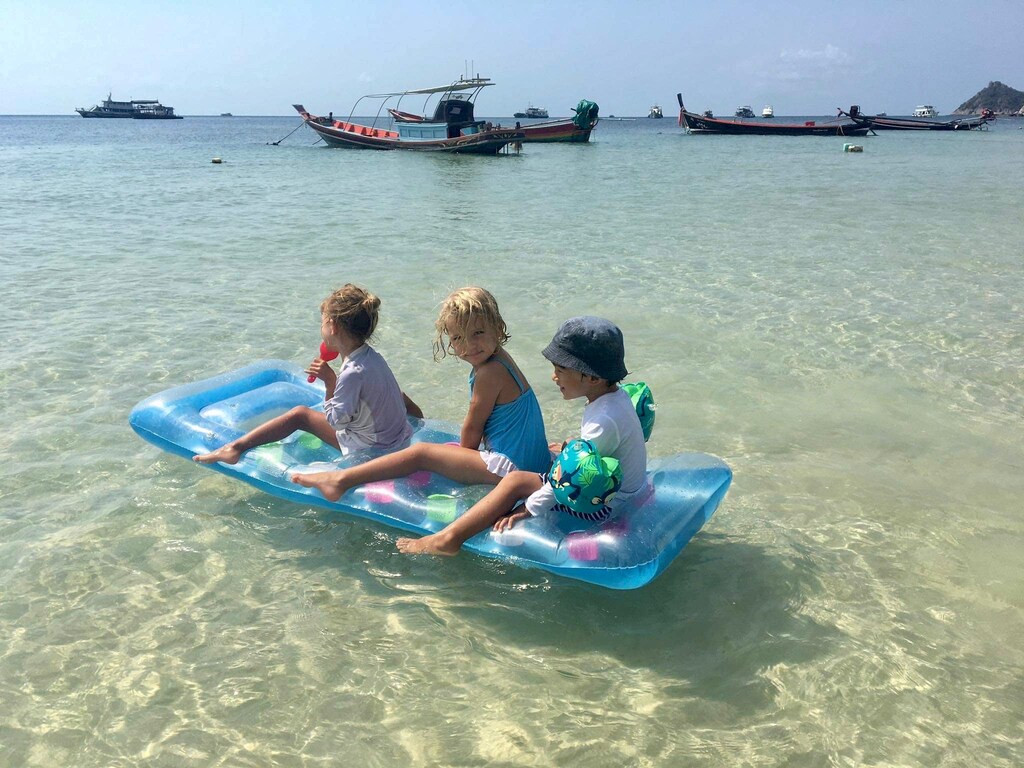
Transportation in Thailand
People often ask how we get from A to B in Thailand. The answer depends entirely on where you live and how comfortable you are with a scooter or car.
In large cities like Bangkok, you can easily get around with the MRT (Mass Rapid Transit) and Grab (taxi). However, in places like Phuket and Koh Samui, you’ll definitely need a car (be aware that most rental cars don’t come with kids’ car seats; if you need one, you can order it on Lazada).
In rural areas or on small islands like Koh Phangan or Koh Tao, we prefer to ride scooters, even though the quality of the roads and general road safety can be poor. Scooters allow us to park easily and overtake slow salengs (scooters with sidecars) or trucks more efficiently.
However, it’s also more dangerous, especially during the high season when the tourist masses arrive, bringing many inexperienced and sometimes drunk drivers. That’s definitely a downside of living in Thailand with kids.
Tips for Safe Scooter Riding in Thailand With Children
- Rent or buy a larger scooter with more space and power. We have an ADV 160 and a PCX 160, both of which are great for everyday use.
- Always wear a full-face helmet. Not only is it much safer in case of an accident, but the visor also protects you from sand, insects, rain, and sun.
- Never have more than 3 people on a scooter, and by that, I mean 2 adults and one child at most. Since we have two small children, we usually split up: one adult and one child per scooter.
- If your children are too small to hold on by themselves, take them in a baby carrier. They can wear helmets in it too. There are also special cushions that extend the seat of the scooter, giving the child more space.

Benefits of Living in Thailand with Kids
Lower Cost of Living
The low cost of living is one of the main reasons why living in Thailand with kids is so attractive to Westerners. You simply get more for your money here—whether it’s services, food, or accommodation.
We love taking advantage of geo-arbitrage, earning our money in high-cost countries like Germany and the U.S. but spending it in Southeast Asia.
The only downside: you get used to the low costs very quickly. When you go back to a high-cost country, the high prices can be shocking! I was stunned when we first returned to Germany, and a simple meal cost over 10 euros.
Here, I describe our cost of living in Koh Phangan in detail.
Rich Cultural Experiences
Thai culture is truly something special. From the stunning temples and ubiquitous monks to the bustling night markets, it’s incredibly diverse. Above all, it’s heartwarming and kind.
According to the World Population Review, approximately 93-94% of Thais adhere to Buddhism, specifically the Theravada tradition, which is the dominant school of Buddhism in the country. This makes Thailand one of the countries with the highest proportion of Buddhists in the world.
You can see this influence in many aspects of daily life, such as the care for street dogs and the deep respect and love shown to the elderly.
The same goes for the affection towards children. I’ve never seen a Thai person, at least visibly, get annoyed with my children (or any Thai children). On the contrary, sometimes, I have to protect the kids from too much love, especially when they are sick or extremely tired and not in the mood to interact.
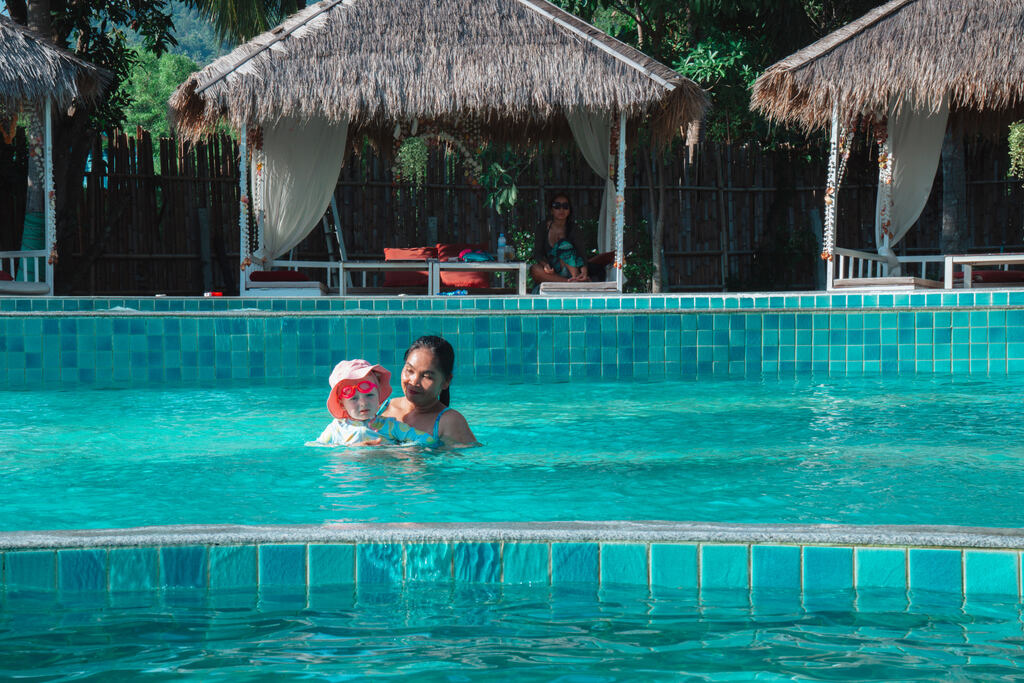
Delicious and Safe Food Options
As vegetarians, we mostly have no problem finding suitable food in Thailand. Especially in tourist areas, restaurants are well-prepared for vegetarians and offer alternatives with tofu.
However, if you want to avoid animal products, it’s important to mention that you don’t want fish sauce or oyster sauce. Even when ordering a tofu pad thai, I always say: “Mai sai fish sauce, mai sai oyster sauce ka” (Don’t put fish sauce or oyster sauce, please).
Regarding food safety, I can’t say it’s always 100 percent safe, but we rarely have stomach problems. If we do, it usually happens after eating at street stalls. Not eating meat and fish definitely helps reduce the risk of food poisoning.
Generally, it’s safe to order ice cubes, eat salad, and rinse your mouth with tap water after brushing your teeth.
My Resources for Families Considering the Move to Thailand
Here are a few final tips and resources that might help you:
- Learn all about packing essentials as a digital nomad family.
- Discover how to become a digital nomad family.
- Get tips on how to make money while traveling around the world.
- Find the best kids’ activities in Koh Phangan, Bangkok, and Chiang Mai.
- Read interviews with families about the best area in Koh Phangan for families.
- Check out what to wear in Thailand and which vaccines you need.

Final Thoughts on Living in Thailand as a Family
Living in Thailand with kids has been one of the most transformative and fulfilling experiences for our entire family. From the moment we decided to escape the grind of our 9-5 jobs in Germany and embrace a new lifestyle as digital nomads, we knew we were in for an adventure.
The cost of living is remarkably low, allowing us to enjoy a higher quality of life and invest more time in our family and personal passions. The education system, while different, has provided our children with excellent learning opportunities.
If you and your family are considering a move to the Land of Smiles, I encourage you to take the plunge. It’s a great place to live a happy, fulfilling digital nomad family life.
Prepare thoroughly, keep an open mind, and be ready for an adventure. Thailand has so much to offer, and it might just be the best decision you make for your family’s happiness and growth.
Do you plan to move to Thailand? Do you have any questions left? Please let me know in the comments! I’d love to help!
Thank you for reading and for making me part of your day! Yours, Lulu
Just a heads up: some links in the article “Living in Thailand with Kids” on Nomadmum.com are affiliate links. This means if you click and buy, I might earn a small commission at no extra cost to you.








2 Responses
Hi I’d like to know what are the options for kid school or education in Thailand. I can’t afford international school. They’re extremely expensive.
I’m Thai but married an American and have 2 beautiful kids. 6 and 10. Everytime I’m back to Thailand. I always thinking about moving back there. Because I want my kids to experience culture, activities, and be more outdoor. It’s not much activities where I live in the US. It’s cold for 6-7 months. Love to hear your advice! Tia!
Hi Taai,
Thanks for sharing your story! Local public schools in Thailand are almost free of charge, as far as I know, and could be a great option. Since your kids are half-Thai, they should be able to enroll without much issue. The main language is Thai, so you should keep that in mind.
In smaller areas like Koh Tao, local schools even accept non-Thai kids. I recommend contacting the school in the area you’re considering to ask about enrollment and requirements.
Hope this helps! Let me know if you have more questions. Lulu